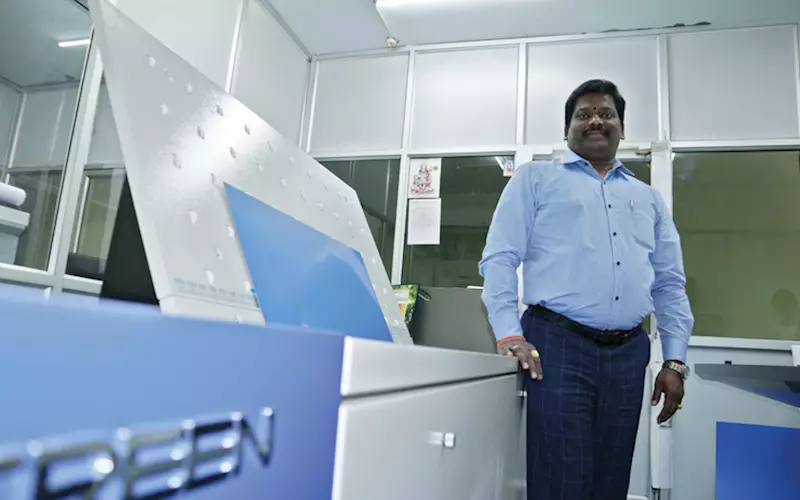Sphoorthi: From typesetter to print operation
N Narayana Rao started off his business as a typesetting firm 25 years ago. In 2012, the managing director of Sphoorthi Printers entered print business with the installation of a pre-owned Komori Lithrone 426 four-colour press.
10 Jun 2019 | By PrintWeek India
Six months later, he installed a pre-owned Screen CTP and then in the next six months, a second pre-owned Komori four-colour press.
But how easy was it to turn a typesetting firm into a print company? It certainly wasn’t, particularly when a big chunk of the print market in Hyderabad is competing on price. “Before starting the print business, I surveyed the market and wrote down 100 points in my diary, which had both problems as well as solutions. I could attack the problems because I knew them,” says Rao.
However, there was one point – quality –Rao discovered, when he set about setting up his business. “For me, print quality is getting consistency – from design to proof to final print. They should look uniform,” says Rao.
Compete on quality, not price
Five years ago, Sphoorthi was using plates with which it had issues. It helped to use TechNova’s Elite plates, which were more expensive than the plates it used earlier. “We were not getting the desired quality prints with the earlier plate.
The Elite is a double-layered plate, which results in fine dots, which improved our print quality. As a result, quality jobs started coming in. Our jobs increased, so did our plate consumption,” says Rao, adding, “I believe 70% of print quality comes from a better quality of plates.”
Recently, Sphoorthi upgraded its Screen CTP to a PlateRite 8600 MII-S, a thermal CTP platesetter. “The earlier Screen platesetter was a used machine, this one is a brand new kit. But, in terms of quality, Screen CTP is a proven technology, and since we have used the kit, we were sure of the quality it can produce,” says Rao.
Sphoorthi fired around 4,000 plates per month with the old platesetter, and with the new, bigger size – 28x40inch – with higher speed, the firm is in a position to print more, quickly.
The print firm specialises in commercial jobs such as brochures, catalogues and collaterals among others. These are job works – just print and supply, which is 90% of its business pie. Sphoorthi is equipped with finishing equipment for creasing and lamination, while it outsources folding and binding for customers who demand complete products.
According to Rao, Sphoorthi produces around 1,000 jobs per month and during peak seasons struggled to meet deadlines because it could not produce plates to feed the two presses. “If we required 10 sets or 40 plates, it took us two hours. Now we can get it in a little over an hour. Earlier we used the CTP system for 20 hours, now we are getting the same output in 12 hours; that’s saving on time and electricity. Plus, it leaves us with extra capacity,” says Rao.
Build a reputation
Lakdi ka Pool is home to about 100 print companies including big names like Pragati, Caxton and Vamsi. “We were the last one to start a business here. Yet in the last 10 years, Sphoorthi is the only one to install a new Screen CTP in the area,” says Rao with pride.
Rao says, there are print companies in the area who are using cheaper CTCP plates, but are not able to match his quality and success. “Despite charging more cost for printing jobs, we are doing more jobs than other printers.”
Print quality, low waste and timely delivery is Rao’s mantra. “I don’t have to search for customers. Once a customer gets his print from us, we are sure he will not go anywhere else because of the quality. For jobs where he himself does not get enough margins, he may go elsewhere,” says Rao.
Future is digital?
Not yet, predicts Rao. “Not at least in Hyderabad,” he says. There are two reasons for Rao’s assertion. One is quality and second is resale value of a digital kit. “Digital is still close to offset, not offset yet,” says Rao.
Some digital kit, Rao says, costs Rs 10-15 crores. “I do not know if I will be able to recover the cost in three to five years time. And if I decide to sell it after three to five years, it will not fetch me more than 25% of the cost.”
Rao says he bought a pre-owned press in 2012 for Rs 95-lakh, ran it and earned seven times, and when I sell it I can still recover more than 75% of the cost. “Can a digital kit fetch me so much after a seven-year use,” Rao asks.
Sphoorthi operates from a 3,000 sqft site and employs 40 people. “With the new investment in CTP, and the quality we are able to produce, our customers are more inclined to execute jobs from us, because of the ‘point of difference’,” says Rao.
“There’s competition, price pressures, and lots of hard work, but for me, the positives of the outcome thus far, outweigh the negatives,” concludes Rao.














 See All
See All